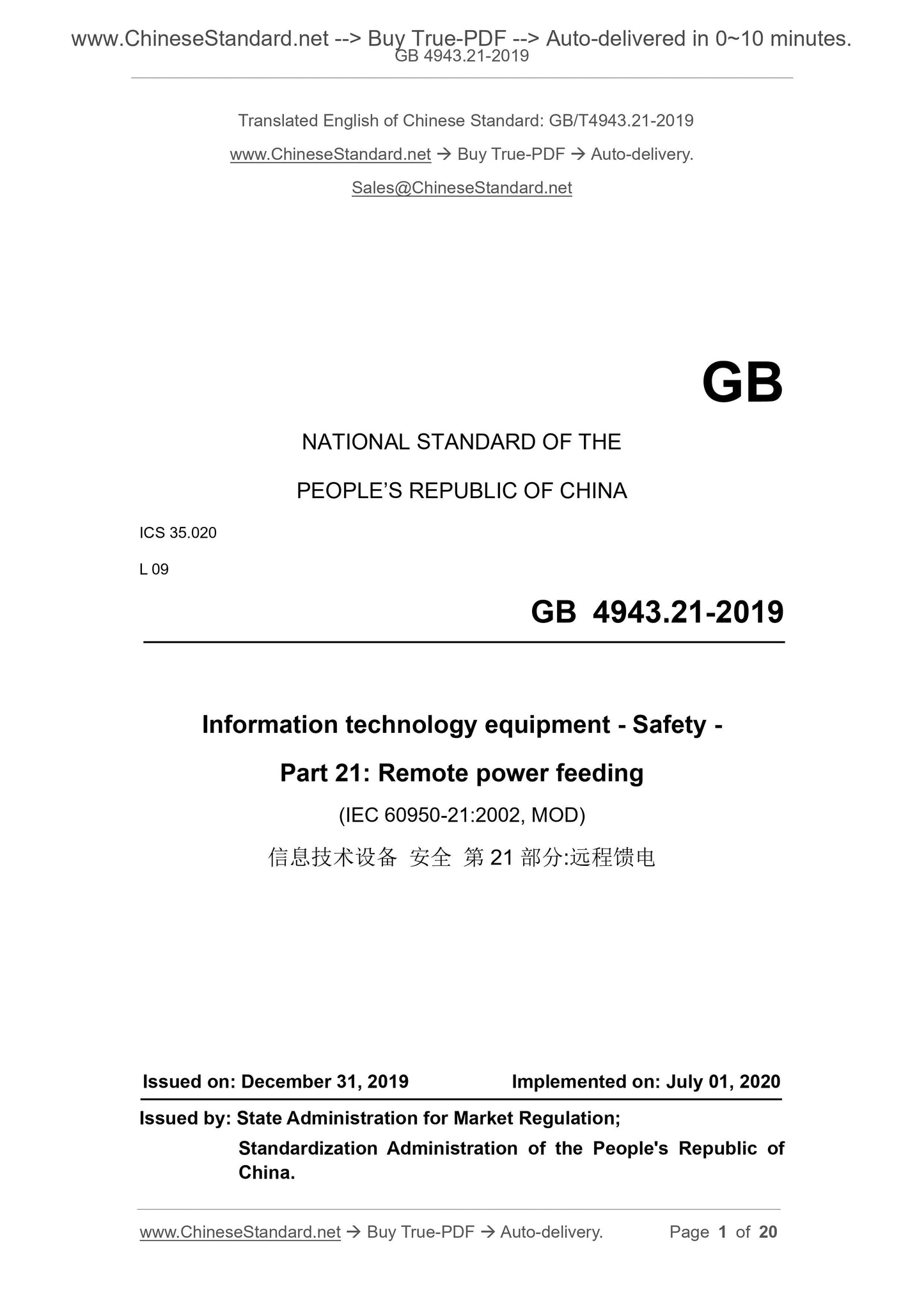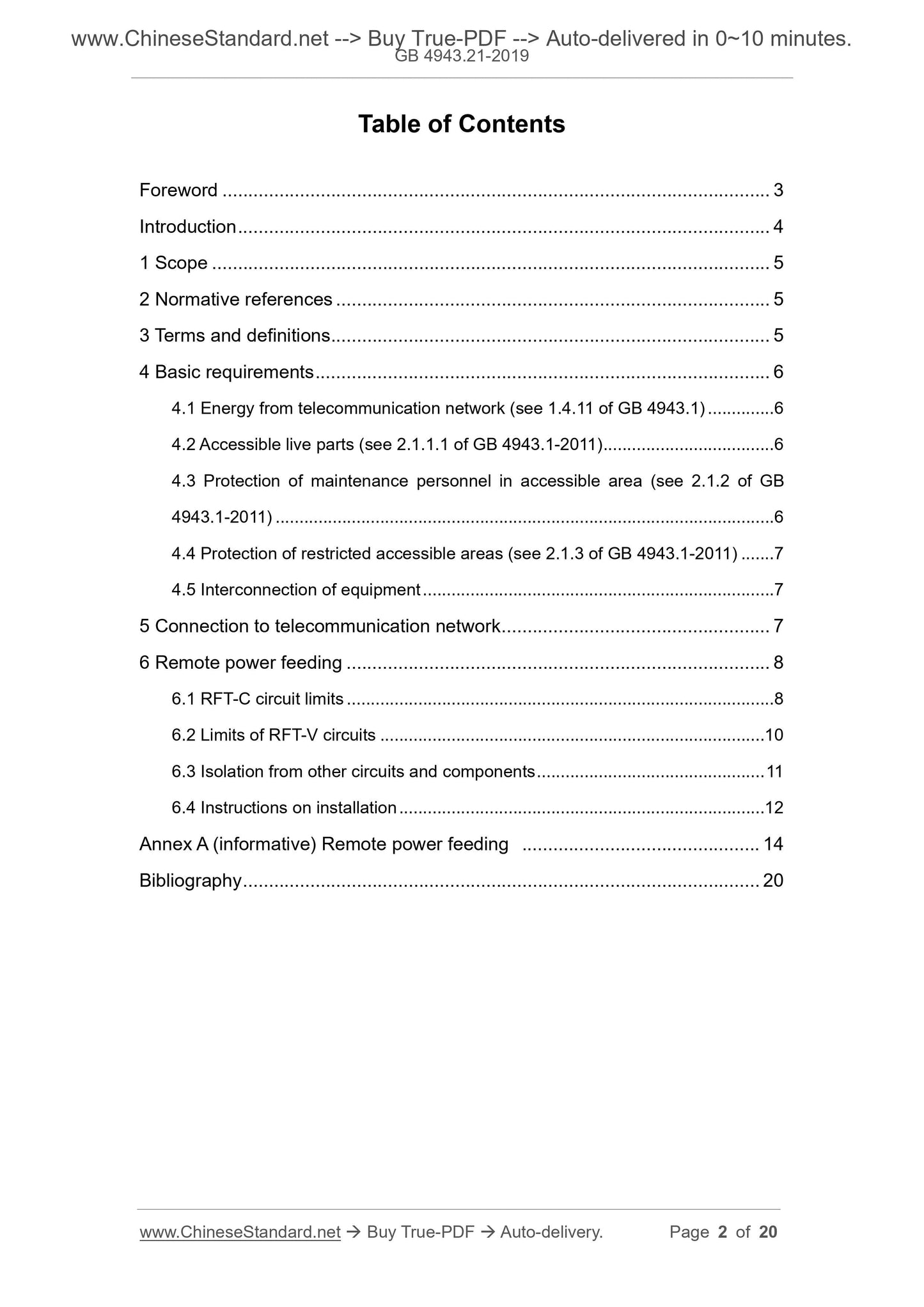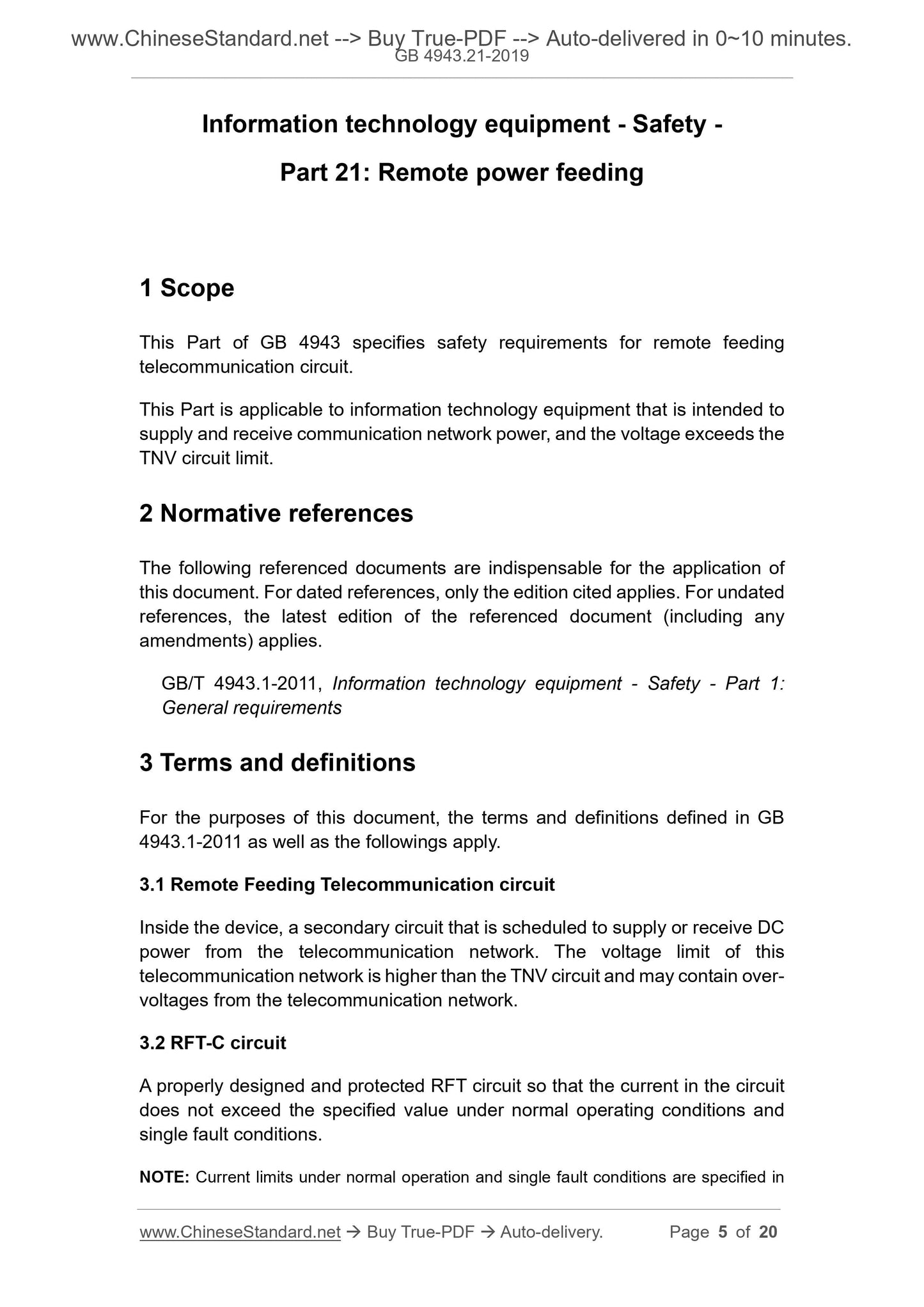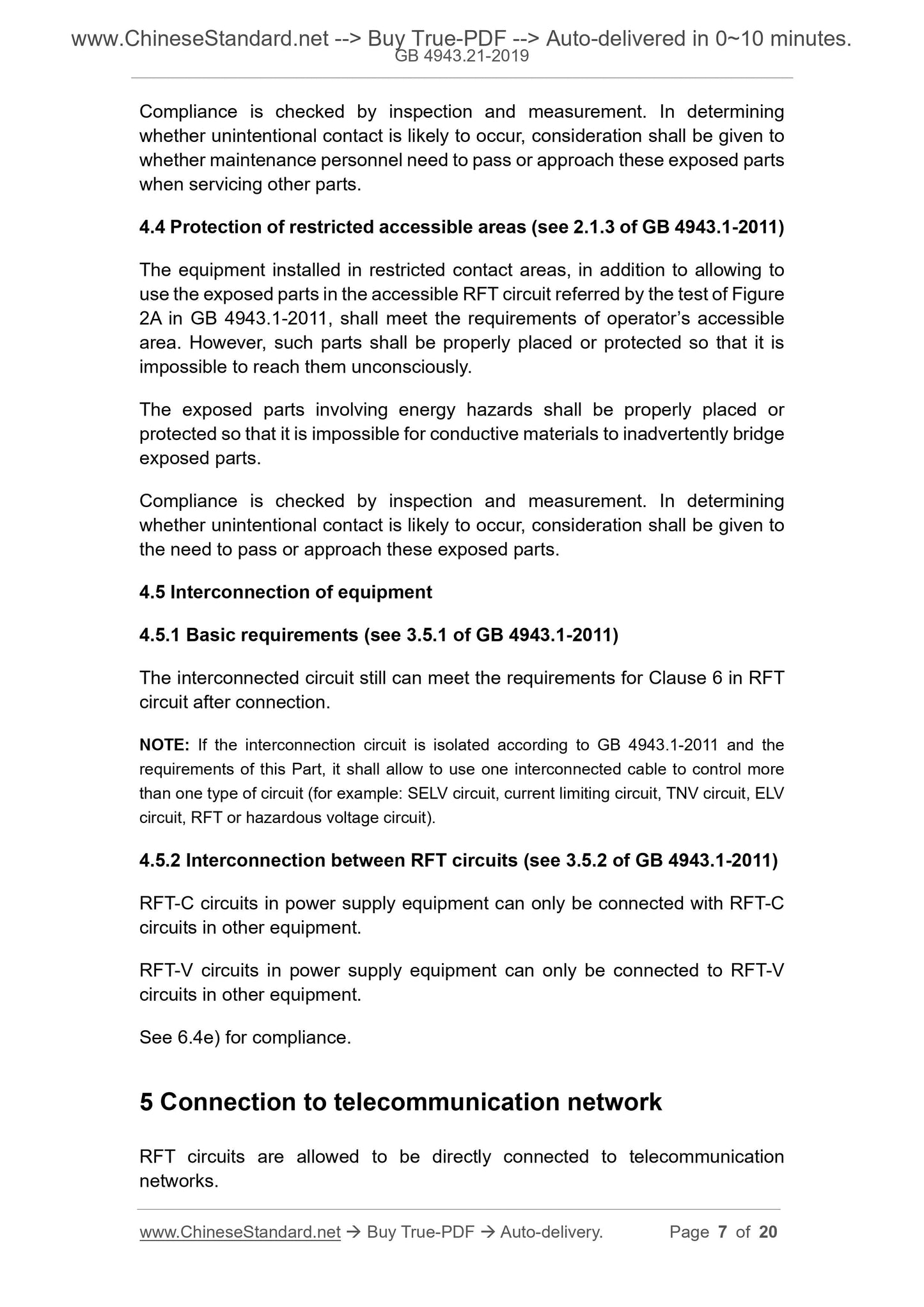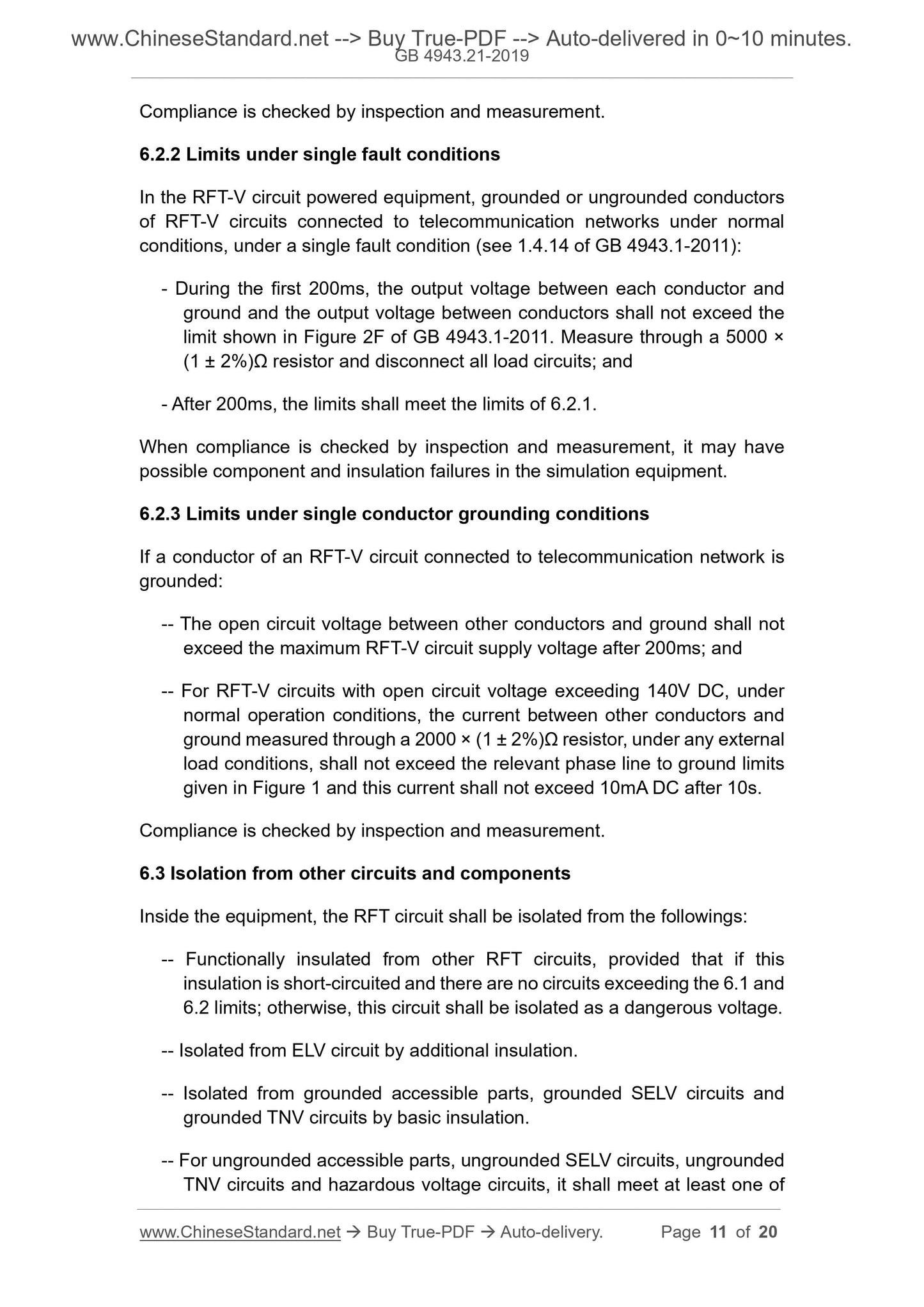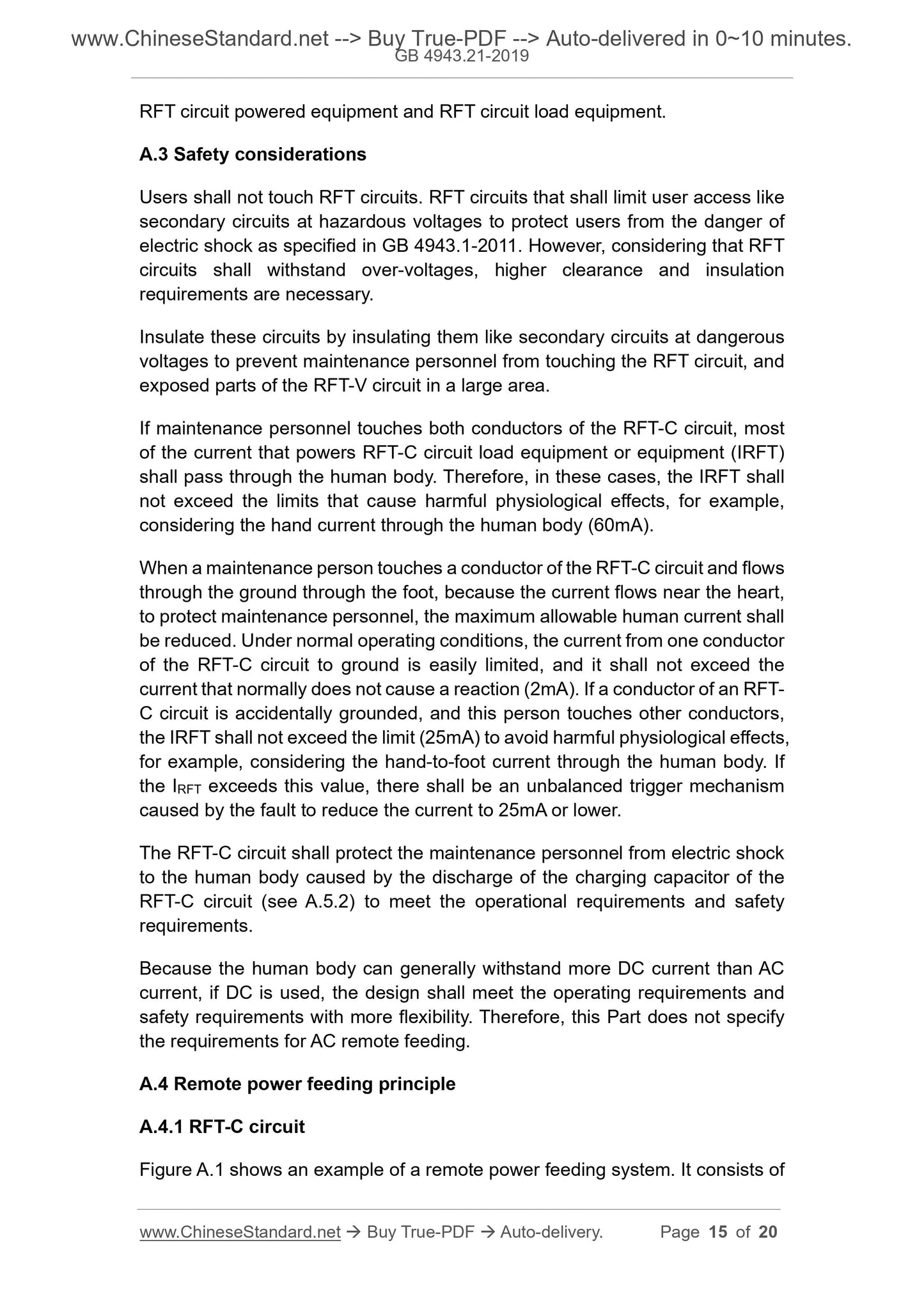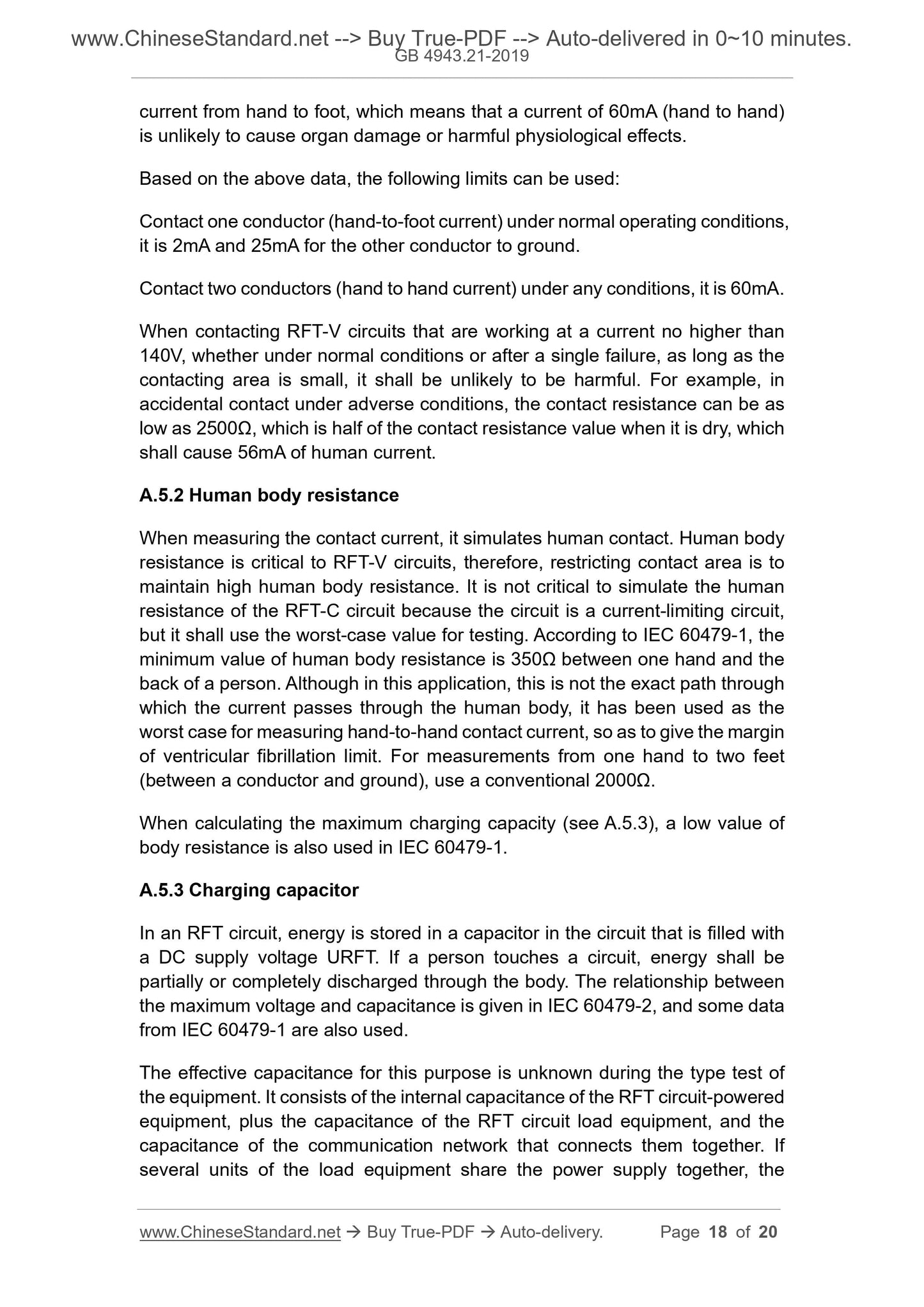1
/
of
7
PayPal, credit cards. Download editable-PDF & invoice in 1 second!
GB 4943.21-2019 English PDF (GB4943.21-2019)
GB 4943.21-2019 English PDF (GB4943.21-2019)
Regular price
$190.00 USD
Regular price
Sale price
$190.00 USD
Unit price
/
per
Shipping calculated at checkout.
Couldn't load pickup availability
Delivery: 3 seconds. Download true-PDF + Invoice.
Get QUOTATION in 1-minute: Click GB 4943.21-2019
Historical versions: GB 4943.21-2019
Preview True-PDF (Reload/Scroll if blank)
GB 4943.21-2019: Information technology equipment -- Safety -- Part 21: Remote power feeding
GB 4943.21-2019
NATIONAL STANDARD OF THE
PEOPLE’S REPUBLIC OF CHINA
ICS 35.020
L 09
Information technology equipment - Safety -
Part 21: Remote power feeding
(IEC 60950-21:2002, MOD)
ISSUED ON: DECEMBER 31, 2019
IMPLEMENTED ON: JULY 01, 2020
Issued by: State Administration for Market Regulation;
Standardization Administration of the People's Republic of
China.
Table of Contents
Foreword ... 3
Introduction ... 4
1 Scope ... 5
2 Normative references ... 5
3 Terms and definitions ... 5
4 Basic requirements ... 6
4.1 Energy from telecommunication network (see 1.4.11 of GB 4943.1) ... 6
4.2 Accessible live parts (see 2.1.1.1 of GB 4943.1-2011) ... 6
4.3 Protection of maintenance personnel in accessible area (see 2.1.2 of GB
4943.1-2011) ... 6
4.4 Protection of restricted accessible areas (see 2.1.3 of GB 4943.1-2011) ... 7
4.5 Interconnection of equipment ... 7
5 Connection to telecommunication network ... 7
6 Remote power feeding ... 8
6.1 RFT-C circuit limits ... 8
6.2 Limits of RFT-V circuits ... 10
6.3 Isolation from other circuits and components ... 11
6.4 Instructions on installation ... 12
Annex A (informative) Remote power feeding ... 14
Bibliography ... 20
Information technology equipment - Safety -
Part 21: Remote power feeding
1 Scope
This Part of GB 4943 specifies safety requirements for remote feeding
telecommunication circuit.
This Part is applicable to information technology equipment that is intended to
supply and receive communication network power, and the voltage exceeds the
TNV circuit limit.
2 Normative references
The following referenced documents are indispensable for the application of
this document. For dated references, only the edition cited applies. For undated
references, the latest edition of the referenced document (including any
amendments) applies.
GB/T 4943.1-2011, Information technology equipment - Safety - Part 1:
General requirements
3 Terms and definitions
For the purposes of this document, the terms and definitions defined in GB
4943.1-2011 as well as the followings apply.
3.1 Remote Feeding Telecommunication circuit
Inside the device, a secondary circuit that is scheduled to supply or receive DC
power from the telecommunication network. The voltage limit of this
telecommunication network is higher than the TNV circuit and may contain over-
voltages from the telecommunication network.
3.2 RFT-C circuit
A properly designed and protected RFT circuit so that the current in the circuit
does not exceed the specified value under normal operating conditions and
single fault conditions.
NOTE: Current limits under normal operation and single fault conditions are specified in
Compliance is checked by inspection and measurement. In determining
whether unintentional contact is likely to occur, consideration shall be given to
whether maintenance personnel need to pass or approach these exposed parts
when servicing other parts.
4.4 Protection of restricted accessible areas (see 2.1.3 of GB 4943.1-2011)
The equipment installed in restricted contact areas, in addition to allowing to
use the exposed parts in the accessible RFT circuit referred by the test of Figure
2A in GB 4943.1-2011, shall meet the requirements of operator’s accessible
area. However, such parts shall be properly placed or protected so that it is
impossible to reach them unconsciously.
The exposed parts involving energy hazards shall be properly placed or
protected so that it is impossible for conductive materials to inadvertently bridge
exposed parts.
Compliance is checked by inspection and measurement. In determining
whether unintentional contact is likely to occur, consideration shall be given to
the need to pass or approach these exposed parts.
4.5 Interconnection of equipment
4.5.1 Basic requirements (see 3.5.1 of GB 4943.1-2011)
The interconnected circuit still can meet the requirements for Clause 6 in RFT
circuit after connection.
NOTE: If the interconnection circuit is isolated according to GB 4943.1-2011 and the
requirements of this Part, it shall allow to use one interconnected cable to control more
than one type of circuit (for example: SELV circuit, current limiting circuit, TNV circuit, ELV
circuit, RFT or hazardous voltage circuit).
4.5.2 Interconnection between RFT circuits (see 3.5.2 of GB 4943.1-2011)
RFT-C circuits in power supply equipment can only be connected with RFT-C
circuits in other equipment.
RFT-V circuits in power supply equipment can only be connected to RFT-V
circuits in other equipment.
See 6.4e) for compliance.
5 Connection to telecommunication network
RFT circuits are allowed to be directly connected to telecommunication
networks.
Compliance is checked by inspection and measurement.
6.2.2 Limits under single fault conditions
In the RFT-V circuit powered equipment, grounded or ungrounded conductors
of RFT-V circuits connected to telecommunication networks under normal
conditions, under a single fault condition (see 1.4.14 of GB 4943.1-2011):
- During the first 200ms, the output voltage between each conductor and
ground and the output voltage between conductors shall not exceed the
limit shown in Figure 2F of GB 4943.1-2011. Measure through a 5000 ×
(1 ± 2%)Ω resistor and disconnect all load circuits; and
- After 200ms, the limits shall meet the limits of 6.2.1.
When compliance is checked by inspection and measurement, it may have
possible component and insulation failures in the simulation equipment.
6.2.3 Limits under single conductor grounding conditions
If a conductor of an RFT-V circuit connected to telecommunication network is
grounded:
-- The open circuit voltage between other conductors and ground shall not
exceed the maximum RFT-V circuit supply voltage after 200ms; and
-- For RFT-V circuits with open circuit voltage exceeding 140V DC, under
normal operation conditions, the current between other conductors and
ground measured through a 2000 × (1 ± 2%)Ω resistor, under any external
load conditions, shall not exceed the relevant phase line to ground limits
given in Figure 1 and this current shall not exceed 10mA DC after 10s.
Compliance is checked by inspection and measurement.
6.3 Isolation from other circuits and components
Inside the equipment, the RFT circuit shall be isolated from the followings:
-- Functionally insulated from other RFT circuits, provided that if this
insulation is short-circuited and there are no circuits exceeding the 6.1 and
6.2 limits; otherwise, this circuit shall be isolated as a dangerous voltage.
-- Isolated from ELV circuit by additional insulation.
-- Isolated from grounded accessible parts, grounded SELV circuits and
grounded TNV circuits by basic insulation.
-- For ungrounded accessible parts, ungrounded SELV circuits, ungrounded
TNV circuits and hazardous voltage circuits, it shall meet at least one of
RFT circuit powered equipment and RFT circuit load equipment.
A.3 Safety considerations
Users shall not touch RFT circuits. RFT circuits that shall limit user access like
secondary circuits at hazardous voltages to protect users from the danger of
electric shock as specified in GB 4943.1-2011. However, considering that RFT
circuits shall withstand over-voltages, higher clearance and insulation
requirements are necessary.
Insulate these circuits by insulating them like secondary circuits at dangerous
voltage...
Get QUOTATION in 1-minute: Click GB 4943.21-2019
Historical versions: GB 4943.21-2019
Preview True-PDF (Reload/Scroll if blank)
GB 4943.21-2019: Information technology equipment -- Safety -- Part 21: Remote power feeding
GB 4943.21-2019
NATIONAL STANDARD OF THE
PEOPLE’S REPUBLIC OF CHINA
ICS 35.020
L 09
Information technology equipment - Safety -
Part 21: Remote power feeding
(IEC 60950-21:2002, MOD)
ISSUED ON: DECEMBER 31, 2019
IMPLEMENTED ON: JULY 01, 2020
Issued by: State Administration for Market Regulation;
Standardization Administration of the People's Republic of
China.
Table of Contents
Foreword ... 3
Introduction ... 4
1 Scope ... 5
2 Normative references ... 5
3 Terms and definitions ... 5
4 Basic requirements ... 6
4.1 Energy from telecommunication network (see 1.4.11 of GB 4943.1) ... 6
4.2 Accessible live parts (see 2.1.1.1 of GB 4943.1-2011) ... 6
4.3 Protection of maintenance personnel in accessible area (see 2.1.2 of GB
4943.1-2011) ... 6
4.4 Protection of restricted accessible areas (see 2.1.3 of GB 4943.1-2011) ... 7
4.5 Interconnection of equipment ... 7
5 Connection to telecommunication network ... 7
6 Remote power feeding ... 8
6.1 RFT-C circuit limits ... 8
6.2 Limits of RFT-V circuits ... 10
6.3 Isolation from other circuits and components ... 11
6.4 Instructions on installation ... 12
Annex A (informative) Remote power feeding ... 14
Bibliography ... 20
Information technology equipment - Safety -
Part 21: Remote power feeding
1 Scope
This Part of GB 4943 specifies safety requirements for remote feeding
telecommunication circuit.
This Part is applicable to information technology equipment that is intended to
supply and receive communication network power, and the voltage exceeds the
TNV circuit limit.
2 Normative references
The following referenced documents are indispensable for the application of
this document. For dated references, only the edition cited applies. For undated
references, the latest edition of the referenced document (including any
amendments) applies.
GB/T 4943.1-2011, Information technology equipment - Safety - Part 1:
General requirements
3 Terms and definitions
For the purposes of this document, the terms and definitions defined in GB
4943.1-2011 as well as the followings apply.
3.1 Remote Feeding Telecommunication circuit
Inside the device, a secondary circuit that is scheduled to supply or receive DC
power from the telecommunication network. The voltage limit of this
telecommunication network is higher than the TNV circuit and may contain over-
voltages from the telecommunication network.
3.2 RFT-C circuit
A properly designed and protected RFT circuit so that the current in the circuit
does not exceed the specified value under normal operating conditions and
single fault conditions.
NOTE: Current limits under normal operation and single fault conditions are specified in
Compliance is checked by inspection and measurement. In determining
whether unintentional contact is likely to occur, consideration shall be given to
whether maintenance personnel need to pass or approach these exposed parts
when servicing other parts.
4.4 Protection of restricted accessible areas (see 2.1.3 of GB 4943.1-2011)
The equipment installed in restricted contact areas, in addition to allowing to
use the exposed parts in the accessible RFT circuit referred by the test of Figure
2A in GB 4943.1-2011, shall meet the requirements of operator’s accessible
area. However, such parts shall be properly placed or protected so that it is
impossible to reach them unconsciously.
The exposed parts involving energy hazards shall be properly placed or
protected so that it is impossible for conductive materials to inadvertently bridge
exposed parts.
Compliance is checked by inspection and measurement. In determining
whether unintentional contact is likely to occur, consideration shall be given to
the need to pass or approach these exposed parts.
4.5 Interconnection of equipment
4.5.1 Basic requirements (see 3.5.1 of GB 4943.1-2011)
The interconnected circuit still can meet the requirements for Clause 6 in RFT
circuit after connection.
NOTE: If the interconnection circuit is isolated according to GB 4943.1-2011 and the
requirements of this Part, it shall allow to use one interconnected cable to control more
than one type of circuit (for example: SELV circuit, current limiting circuit, TNV circuit, ELV
circuit, RFT or hazardous voltage circuit).
4.5.2 Interconnection between RFT circuits (see 3.5.2 of GB 4943.1-2011)
RFT-C circuits in power supply equipment can only be connected with RFT-C
circuits in other equipment.
RFT-V circuits in power supply equipment can only be connected to RFT-V
circuits in other equipment.
See 6.4e) for compliance.
5 Connection to telecommunication network
RFT circuits are allowed to be directly connected to telecommunication
networks.
Compliance is checked by inspection and measurement.
6.2.2 Limits under single fault conditions
In the RFT-V circuit powered equipment, grounded or ungrounded conductors
of RFT-V circuits connected to telecommunication networks under normal
conditions, under a single fault condition (see 1.4.14 of GB 4943.1-2011):
- During the first 200ms, the output voltage between each conductor and
ground and the output voltage between conductors shall not exceed the
limit shown in Figure 2F of GB 4943.1-2011. Measure through a 5000 ×
(1 ± 2%)Ω resistor and disconnect all load circuits; and
- After 200ms, the limits shall meet the limits of 6.2.1.
When compliance is checked by inspection and measurement, it may have
possible component and insulation failures in the simulation equipment.
6.2.3 Limits under single conductor grounding conditions
If a conductor of an RFT-V circuit connected to telecommunication network is
grounded:
-- The open circuit voltage between other conductors and ground shall not
exceed the maximum RFT-V circuit supply voltage after 200ms; and
-- For RFT-V circuits with open circuit voltage exceeding 140V DC, under
normal operation conditions, the current between other conductors and
ground measured through a 2000 × (1 ± 2%)Ω resistor, under any external
load conditions, shall not exceed the relevant phase line to ground limits
given in Figure 1 and this current shall not exceed 10mA DC after 10s.
Compliance is checked by inspection and measurement.
6.3 Isolation from other circuits and components
Inside the equipment, the RFT circuit shall be isolated from the followings:
-- Functionally insulated from other RFT circuits, provided that if this
insulation is short-circuited and there are no circuits exceeding the 6.1 and
6.2 limits; otherwise, this circuit shall be isolated as a dangerous voltage.
-- Isolated from ELV circuit by additional insulation.
-- Isolated from grounded accessible parts, grounded SELV circuits and
grounded TNV circuits by basic insulation.
-- For ungrounded accessible parts, ungrounded SELV circuits, ungrounded
TNV circuits and hazardous voltage circuits, it shall meet at least one of
RFT circuit powered equipment and RFT circuit load equipment.
A.3 Safety considerations
Users shall not touch RFT circuits. RFT circuits that shall limit user access like
secondary circuits at hazardous voltages to protect users from the danger of
electric shock as specified in GB 4943.1-2011. However, considering that RFT
circuits shall withstand over-voltages, higher clearance and insulation
requirements are necessary.
Insulate these circuits by insulating them like secondary circuits at dangerous
voltage...
Share
